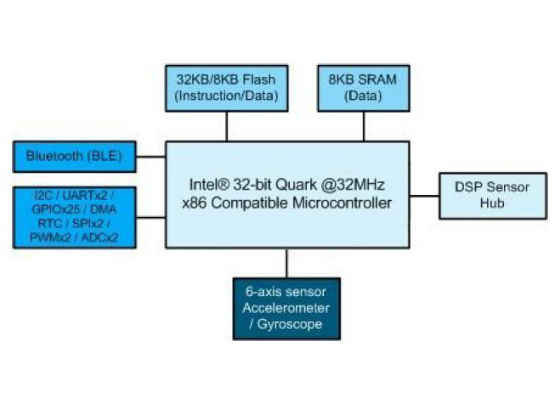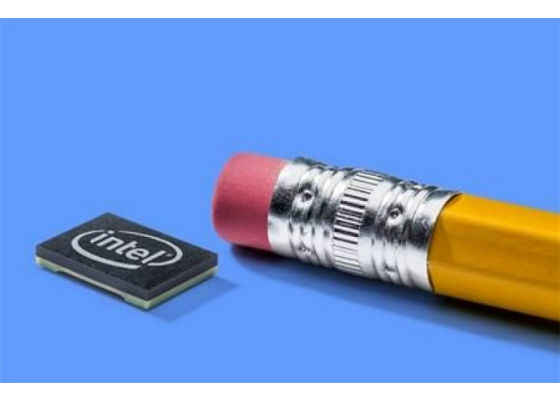Design with the Intel Curie Compute Module

Gartner predicts that in 2016, 6.4 billion connected “things” will exist. Much of that growth is in the consumer space, where opportunities abound for wearable devices. But bringing new wearables into existence requires basic capabilities, for example: detecting movement, processing that data, and making it available for use in a power-efficient way. Intel designed the Intel® Curie™ module for just this application.
The Intel® Curie™ compute module is a low-power hardware module for industrial edge devices and consumer devices such as wearables. It also includes a software platform specifically for this module. This article explores the ideas behind the Intel® Curie™ platform, its key elements, the benefits you could realize through this enabling edge technology in your Internet of Things (IoT) apps, and how it could radically change the landscape of Internet of Things products.
What Is the Intel® Curie™ Module?
The Intel® Curie™ module is a new hardware product that creates a complete, low-power solution for IoT apps. It incorporates numerous features that make it ideal for the “always-on” fitness or healthcare IoT space. You’ll find a compute engine (Intel® Quark™ processor), motion and temperature sensors, Bluetooth® Low Energy (Bluetooth® LE) for communication, and a range of interfaces with a battery charge controller. The motion sensor is a six-axis combo sensor that includes a three-axis accelerometer and a three-axis gyroscope; it measures acceleration and rotation in three axes.
You’ll also find a digital signal processor (DSP) sensor hub that can easily and accurately identify actions and motions of the device using data from the six-axis combo sensor (see Figure 1). This pattern-matching accelerator is a key design element for wearables, and you can use it to perform fast and accurate gesture detection.
Figure 1. Simple Block Diagram of the Intel® Curie™ module
You can extend the Intel® Curie™ module through interfaces. Interface options include I2C, SPI, UART (serial port), and many general-purpose input/output pins. The board also has a USB interface for programming and debugging the module’s firmware.
The Intel® Curie™ module will include a new software platform created specifically for it. This means that you have the necessary hardware and software components to build apps quickly. Get more information on this upcoming SDK.
Benefits of the Intel® Curie™ Module
Beyond the innovative architecture of the Intel® Curie™ module, there are several other benefits to consider:
- The module is a tiny device packed with features that can operate from a coin-sized battery.
- The module is packed with security features at the hardware and firmware level that protect both the data originating from the device and the code running on the device.
- The module will include the necessary firmware and software for a variety of use models as well as a software development kit focused on building efficient code for the Intel® Curie™ platform.
With all the features available and the ability to expand functionality through a range of interfaces, you’ll also enjoy quick time to market: Just add your firmware. The Intel® Curie™ module, shown in Figure 2, may be small, but it’s packed with features and new opportunities.
Figure 2. The Intel® Curie™ module is about the size of a pencil eraser.
Apps That Intel Curie Technology Makes Possible
Intel demonstrated the Intel® Curie™ module in the 2015 Winter X Games. By attaching it to a snowboard, Intel could measure the speed, height, distance, air time, flip, rotation, g-force, and even the landing impact for a jump over the duration of a snowboarder’s run.
Similar to what’s going on in Formula 1* racing telemetry, the Intel® Curie™ module enables data collection during a broad range of activities. The module’s minimal onboard memory resources will certainly restrict the apps that are possible, but there’s enough to do some amazing things. Let’s look at some of the applications that Intel® Curie™ technology makes
possible:
- Sports and Fitness – Imagine the Intel® Curie™ module embedded in the head of a golf club, measuring all aspects of a golfer’s swing. Or embedded within a football, measuring the arc and spiral from a quarterback’s throw. Or in a skateboard, measuring kick flips and other tricks, recording them for play-back later on a computer. You could also embed an Intel® Curie™ module in a shirt collar to provide feedback when a sit-up or push-up doesn’t meet someone’s workout requirements. The size and minimal power requirements of the Intel® Curie™ module enable many applications that before could not be achieved.
- Health Care – The opportunities for Intel® Curie™ technology in the healthcare space are massive. You can imagine a monitoring device for the elderly that can detect a fall, then notify an attendant or neighbor. The module can record movement during the day to identify when a wearer has met the required level of exercise. In a hospital or residential care setting, the Intel® Curie™ module can detect a patient’s movement and notify a nurse (to avoid a fall).
- Pet Care – What has your dog been doing all day? With Intel® Curie™ technology in her collar, you can see her activity during the day, where she sleeps, and where she gets into trouble. With additional sensors, you can monitor her overall health and have the module notify you if her temperature or respiration don’t fit within prescribed normal ranges.
- Fleet Monitoring – The Intel® Curie™ module is so small you could embed it within a tire and identify wobble or a worn tire (and notify the vehicle through a Bluetooth® connection). The accelerometer and gyroscope can map a car’s movement in any direction and acceleration for accident playback or to ensure that drivers aren’t exceeding desired parameters for vehicle operation.
- Civil Engineering – Imagine an array of Intel® Curie™ modules scattered around a building or bridge, measuring small amounts of movement. During an earthquake or windstorm, you could use these sensor arrays to measure movement around the structure to determine whether it exceeds its tolerances.
Example Application
Consider an assisted care scenario to see where you could apply Intel® Curie™ technology capabilities:
- With the module’s small size (about 18 mm across in a circular board design), you could use the device in a small badge that patients can wear on a hospital gown.
- Using the six-axis combo sensor, the module can detect patient movement in an optimal fashion by using the module’s pattern-matching accelerator.
- With detection of movement, the onboard firmware can use the Bluetooth® LE wireless interface to notify an attendant. In particular, this application would exploit the Bluetooth® LE “find me” application profile to identify the rough location of the patient through receivers placed throughout the hospital.
- You could extend the app by using the Bluetooth® LE proximity application profile to identify when the patient has entered a prohibited area of the hospital (such as a hospital exit or another patient’s room).
- Finally, you could exploit the Bluetooth® LE battery application profile to report battery state and charge level, ensuring that the badge is always operable.
- Hospital personnel could use such a device, as well, to keep track of employee location and optimize notification of emergencies to those attendants closest to the patient.
Summary
The Intel® Curie™ module is small, but the opportunities that it creates are boundless. By creating a tiny device that can operate on a coin-sized battery, the places you can apply Intel® Curie™ technology expand greatly. By accelerating the ability to recognize gestures and motions through the DSP sensor hub, Intel is providing a platform for developers and makers to build devices with new, innovative user interfaces. The introduction of Bluetooth® LE allows the device to communicate with minimal power. It will be exciting to see how Intel® Curie™ technology enables the next big thing in wearable technology.
For more such intel IoT resources and tools from Intel, please visit the Intel® Developer Zone
Source: https://software.intel.com/en-us/articles/designing-with-the-intel-curie-compute-module-in-mind






